Research Design: Impact of Sexual Violence Screening on Victims
VerifiedAdded on 2023/04/24
|11
|2925
|485
Report
AI Summary
This report outlines a research design for a quantitative study investigating the impact of sexual violence screening on victims. The research employs a cross-sectional study design, utilizing an online survey to collect data from a sample of 50 sexual assault victims at a university. The study compares the outcomes of screened and unscreened groups, focusing on healthcare usage, savings, and quality of life. The methodology includes correlation analysis using Pearson Correlation Coefficient Test. The report details the research methods (quantitative), data collection procedures, ethical considerations, and a blueprint of the research process, including literature review, data analysis, and linking findings to research objectives. The study aims to determine the effectiveness of screening programs in improving the well-being of sexual assault survivors.
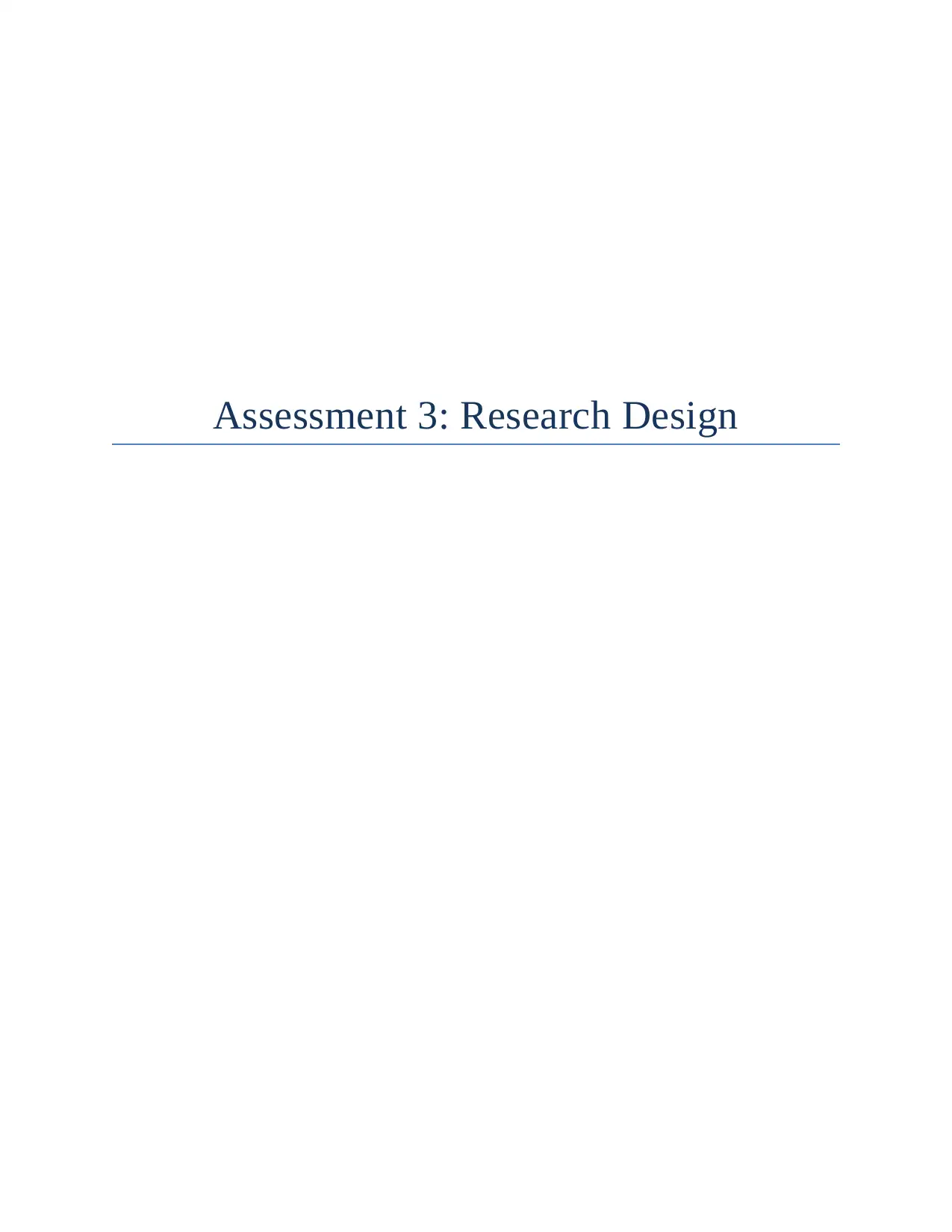
Assessment 3: Research Design
Paraphrase This Document
Need a fresh take? Get an instant paraphrase of this document with our AI Paraphraser
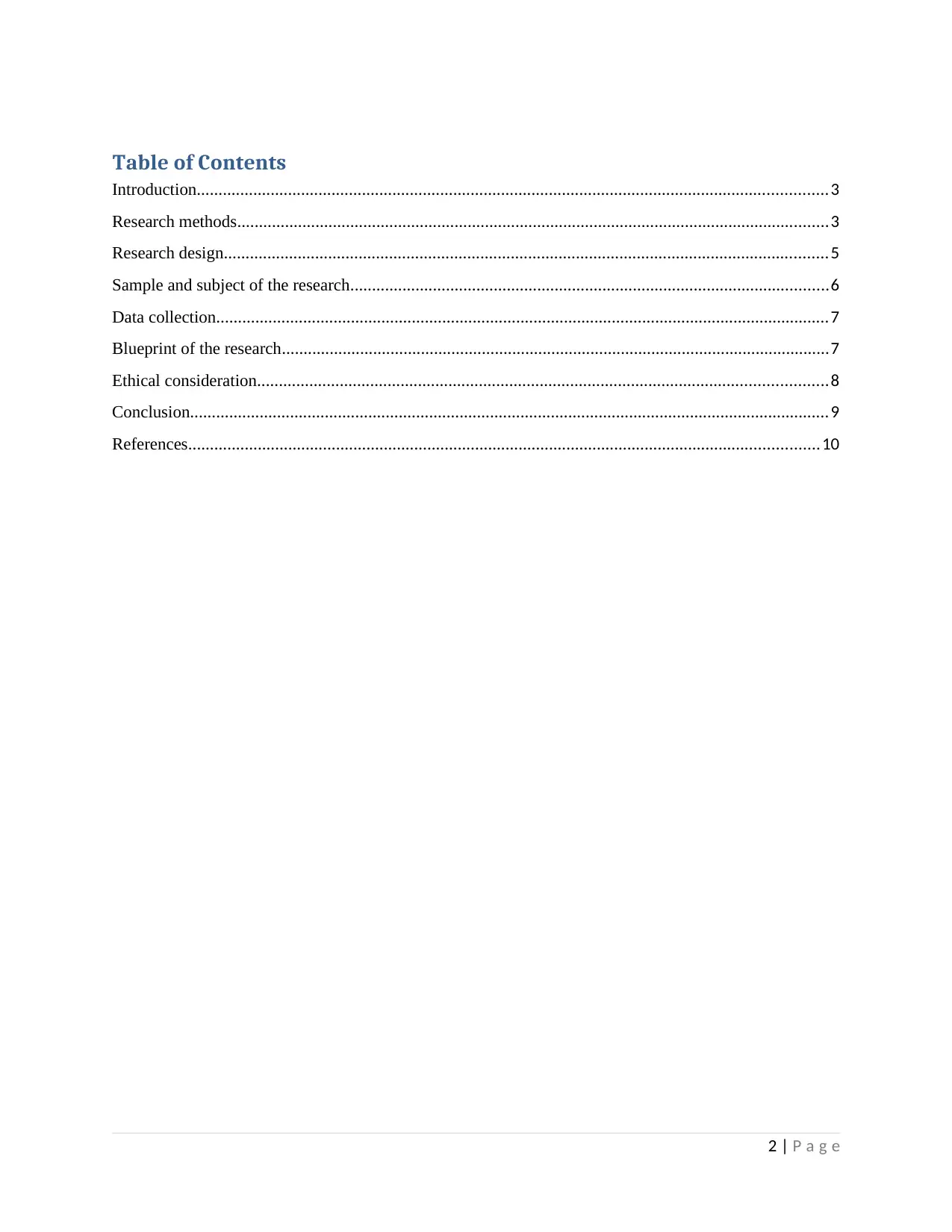
Table of Contents
Introduction.................................................................................................................................................3
Research methods........................................................................................................................................3
Research design...........................................................................................................................................5
Sample and subject of the research..............................................................................................................6
Data collection.............................................................................................................................................7
Blueprint of the research..............................................................................................................................7
Ethical consideration...................................................................................................................................8
Conclusion...................................................................................................................................................9
References.................................................................................................................................................10
2 | P a g e
Introduction.................................................................................................................................................3
Research methods........................................................................................................................................3
Research design...........................................................................................................................................5
Sample and subject of the research..............................................................................................................6
Data collection.............................................................................................................................................7
Blueprint of the research..............................................................................................................................7
Ethical consideration...................................................................................................................................8
Conclusion...................................................................................................................................................9
References.................................................................................................................................................10
2 | P a g e
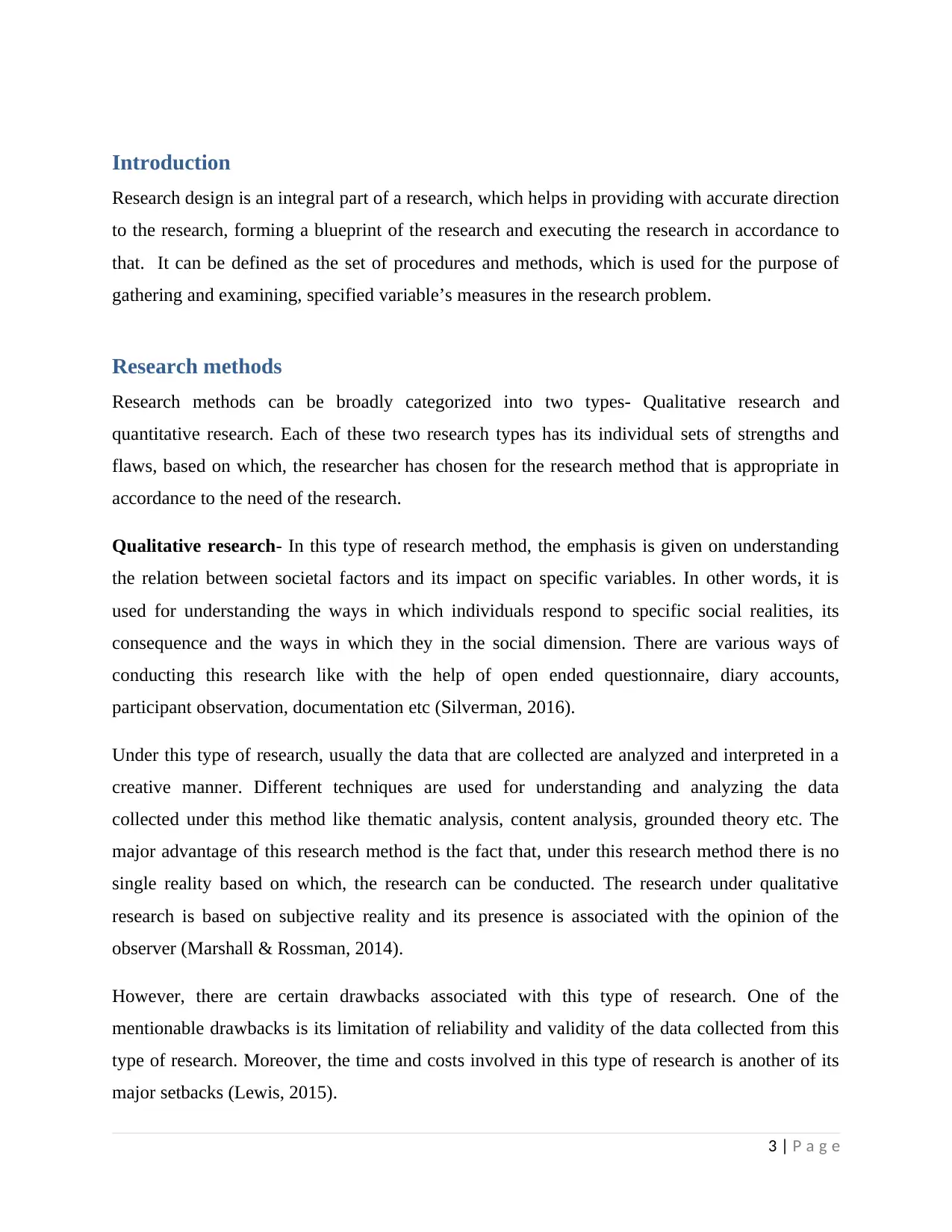
Introduction
Research design is an integral part of a research, which helps in providing with accurate direction
to the research, forming a blueprint of the research and executing the research in accordance to
that. It can be defined as the set of procedures and methods, which is used for the purpose of
gathering and examining, specified variable’s measures in the research problem.
Research methods
Research methods can be broadly categorized into two types- Qualitative research and
quantitative research. Each of these two research types has its individual sets of strengths and
flaws, based on which, the researcher has chosen for the research method that is appropriate in
accordance to the need of the research.
Qualitative research- In this type of research method, the emphasis is given on understanding
the relation between societal factors and its impact on specific variables. In other words, it is
used for understanding the ways in which individuals respond to specific social realities, its
consequence and the ways in which they in the social dimension. There are various ways of
conducting this research like with the help of open ended questionnaire, diary accounts,
participant observation, documentation etc (Silverman, 2016).
Under this type of research, usually the data that are collected are analyzed and interpreted in a
creative manner. Different techniques are used for understanding and analyzing the data
collected under this method like thematic analysis, content analysis, grounded theory etc. The
major advantage of this research method is the fact that, under this research method there is no
single reality based on which, the research can be conducted. The research under qualitative
research is based on subjective reality and its presence is associated with the opinion of the
observer (Marshall & Rossman, 2014).
However, there are certain drawbacks associated with this type of research. One of the
mentionable drawbacks is its limitation of reliability and validity of the data collected from this
type of research. Moreover, the time and costs involved in this type of research is another of its
major setbacks (Lewis, 2015).
3 | P a g e
Research design is an integral part of a research, which helps in providing with accurate direction
to the research, forming a blueprint of the research and executing the research in accordance to
that. It can be defined as the set of procedures and methods, which is used for the purpose of
gathering and examining, specified variable’s measures in the research problem.
Research methods
Research methods can be broadly categorized into two types- Qualitative research and
quantitative research. Each of these two research types has its individual sets of strengths and
flaws, based on which, the researcher has chosen for the research method that is appropriate in
accordance to the need of the research.
Qualitative research- In this type of research method, the emphasis is given on understanding
the relation between societal factors and its impact on specific variables. In other words, it is
used for understanding the ways in which individuals respond to specific social realities, its
consequence and the ways in which they in the social dimension. There are various ways of
conducting this research like with the help of open ended questionnaire, diary accounts,
participant observation, documentation etc (Silverman, 2016).
Under this type of research, usually the data that are collected are analyzed and interpreted in a
creative manner. Different techniques are used for understanding and analyzing the data
collected under this method like thematic analysis, content analysis, grounded theory etc. The
major advantage of this research method is the fact that, under this research method there is no
single reality based on which, the research can be conducted. The research under qualitative
research is based on subjective reality and its presence is associated with the opinion of the
observer (Marshall & Rossman, 2014).
However, there are certain drawbacks associated with this type of research. One of the
mentionable drawbacks is its limitation of reliability and validity of the data collected from this
type of research. Moreover, the time and costs involved in this type of research is another of its
major setbacks (Lewis, 2015).
3 | P a g e
⊘ This is a preview!⊘
Do you want full access?
Subscribe today to unlock all pages.

Trusted by 1+ million students worldwide
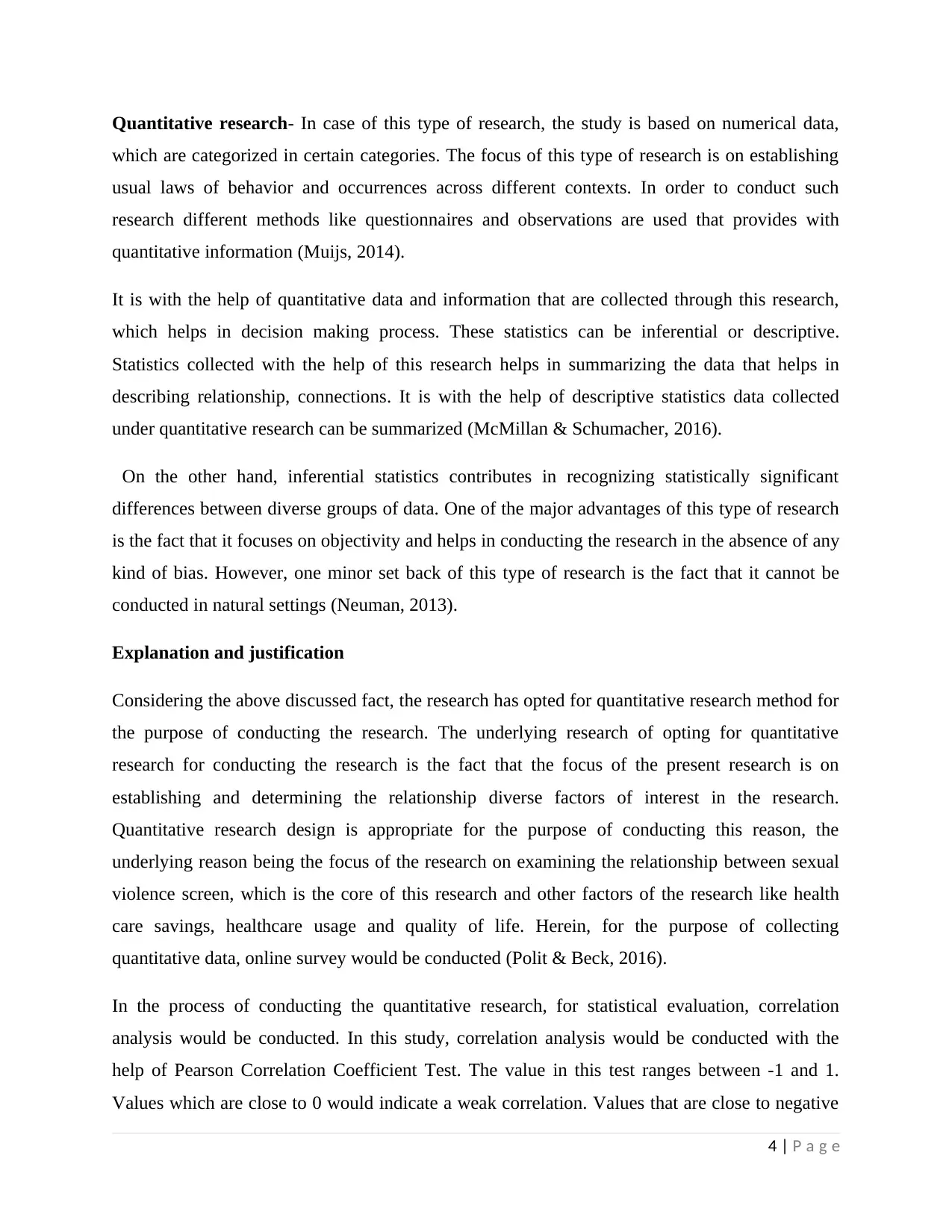
Quantitative research- In case of this type of research, the study is based on numerical data,
which are categorized in certain categories. The focus of this type of research is on establishing
usual laws of behavior and occurrences across different contexts. In order to conduct such
research different methods like questionnaires and observations are used that provides with
quantitative information (Muijs, 2014).
It is with the help of quantitative data and information that are collected through this research,
which helps in decision making process. These statistics can be inferential or descriptive.
Statistics collected with the help of this research helps in summarizing the data that helps in
describing relationship, connections. It is with the help of descriptive statistics data collected
under quantitative research can be summarized (McMillan & Schumacher, 2016).
On the other hand, inferential statistics contributes in recognizing statistically significant
differences between diverse groups of data. One of the major advantages of this type of research
is the fact that it focuses on objectivity and helps in conducting the research in the absence of any
kind of bias. However, one minor set back of this type of research is the fact that it cannot be
conducted in natural settings (Neuman, 2013).
Explanation and justification
Considering the above discussed fact, the research has opted for quantitative research method for
the purpose of conducting the research. The underlying research of opting for quantitative
research for conducting the research is the fact that the focus of the present research is on
establishing and determining the relationship diverse factors of interest in the research.
Quantitative research design is appropriate for the purpose of conducting this reason, the
underlying reason being the focus of the research on examining the relationship between sexual
violence screen, which is the core of this research and other factors of the research like health
care savings, healthcare usage and quality of life. Herein, for the purpose of collecting
quantitative data, online survey would be conducted (Polit & Beck, 2016).
In the process of conducting the quantitative research, for statistical evaluation, correlation
analysis would be conducted. In this study, correlation analysis would be conducted with the
help of Pearson Correlation Coefficient Test. The value in this test ranges between -1 and 1.
Values which are close to 0 would indicate a weak correlation. Values that are close to negative
4 | P a g e
which are categorized in certain categories. The focus of this type of research is on establishing
usual laws of behavior and occurrences across different contexts. In order to conduct such
research different methods like questionnaires and observations are used that provides with
quantitative information (Muijs, 2014).
It is with the help of quantitative data and information that are collected through this research,
which helps in decision making process. These statistics can be inferential or descriptive.
Statistics collected with the help of this research helps in summarizing the data that helps in
describing relationship, connections. It is with the help of descriptive statistics data collected
under quantitative research can be summarized (McMillan & Schumacher, 2016).
On the other hand, inferential statistics contributes in recognizing statistically significant
differences between diverse groups of data. One of the major advantages of this type of research
is the fact that it focuses on objectivity and helps in conducting the research in the absence of any
kind of bias. However, one minor set back of this type of research is the fact that it cannot be
conducted in natural settings (Neuman, 2013).
Explanation and justification
Considering the above discussed fact, the research has opted for quantitative research method for
the purpose of conducting the research. The underlying research of opting for quantitative
research for conducting the research is the fact that the focus of the present research is on
establishing and determining the relationship diverse factors of interest in the research.
Quantitative research design is appropriate for the purpose of conducting this reason, the
underlying reason being the focus of the research on examining the relationship between sexual
violence screen, which is the core of this research and other factors of the research like health
care savings, healthcare usage and quality of life. Herein, for the purpose of collecting
quantitative data, online survey would be conducted (Polit & Beck, 2016).
In the process of conducting the quantitative research, for statistical evaluation, correlation
analysis would be conducted. In this study, correlation analysis would be conducted with the
help of Pearson Correlation Coefficient Test. The value in this test ranges between -1 and 1.
Values which are close to 0 would indicate a weak correlation. Values that are close to negative
4 | P a g e
Paraphrase This Document
Need a fresh take? Get an instant paraphrase of this document with our AI Paraphraser

values would indicate correlation and positive values would indication a positive correlation
(Sedgwick, 2012).
Research design
The nature of the study can be classified into two types- longitudinal studies and cross sectional
studies.
Longitudinal studies- While opting for longitudinal studies, the researcher opts for the same
sample of the target audience. Thus, it can be defined as the observational research method
wherein data is collected from the same subject in a repetitive manner in a specific period of
time. Longitudinal studies are usually conducted on the part of the researcher in order to identify
the cause of occurrence of a particular incident and the following impact of the incident. Thus, it
is with the help of longitudinal study, the risk associated with particular occurrence can be
identified (Malina, Nørreklit & Selto, 2011).. Hence, it is an effective tool for identifying cause
and effective relationship between incident and consequence.
However, one of the major drawbacks of this study is the fact that when it is implemented in case
of medical studies like cancer patients large number of samples are needed to be followed up for
a considerable long period of time, in order to collect meaningful statistical data. Hence, in this
kind of study, wherein follow up is required, it may result in making the study time consuming in
nature (Nakai & Ke, 2011).
Cross sectional study- Cross sectional study is also an observational study. Under this study, the
researcher gathers information and collects data from the sample in the absence of any kind of
manipulation of the environment. Hence, when collecting information with the help of cross
sectional study, it is essential on the part of the researcher to not to influence or interfere the
process. However, one of the major drawbacks of cross sectional study is the fact that, unlike,
longitudinal study, it does not provide with particular information in cause and effect
relationship. The reason being, with the help of cross-sectional study, specific information of one
moment in a time can be collected (Sedgwick, 2014).
Explanation and justification
5 | P a g e
(Sedgwick, 2012).
Research design
The nature of the study can be classified into two types- longitudinal studies and cross sectional
studies.
Longitudinal studies- While opting for longitudinal studies, the researcher opts for the same
sample of the target audience. Thus, it can be defined as the observational research method
wherein data is collected from the same subject in a repetitive manner in a specific period of
time. Longitudinal studies are usually conducted on the part of the researcher in order to identify
the cause of occurrence of a particular incident and the following impact of the incident. Thus, it
is with the help of longitudinal study, the risk associated with particular occurrence can be
identified (Malina, Nørreklit & Selto, 2011).. Hence, it is an effective tool for identifying cause
and effective relationship between incident and consequence.
However, one of the major drawbacks of this study is the fact that when it is implemented in case
of medical studies like cancer patients large number of samples are needed to be followed up for
a considerable long period of time, in order to collect meaningful statistical data. Hence, in this
kind of study, wherein follow up is required, it may result in making the study time consuming in
nature (Nakai & Ke, 2011).
Cross sectional study- Cross sectional study is also an observational study. Under this study, the
researcher gathers information and collects data from the sample in the absence of any kind of
manipulation of the environment. Hence, when collecting information with the help of cross
sectional study, it is essential on the part of the researcher to not to influence or interfere the
process. However, one of the major drawbacks of cross sectional study is the fact that, unlike,
longitudinal study, it does not provide with particular information in cause and effect
relationship. The reason being, with the help of cross-sectional study, specific information of one
moment in a time can be collected (Sedgwick, 2014).
Explanation and justification
5 | P a g e
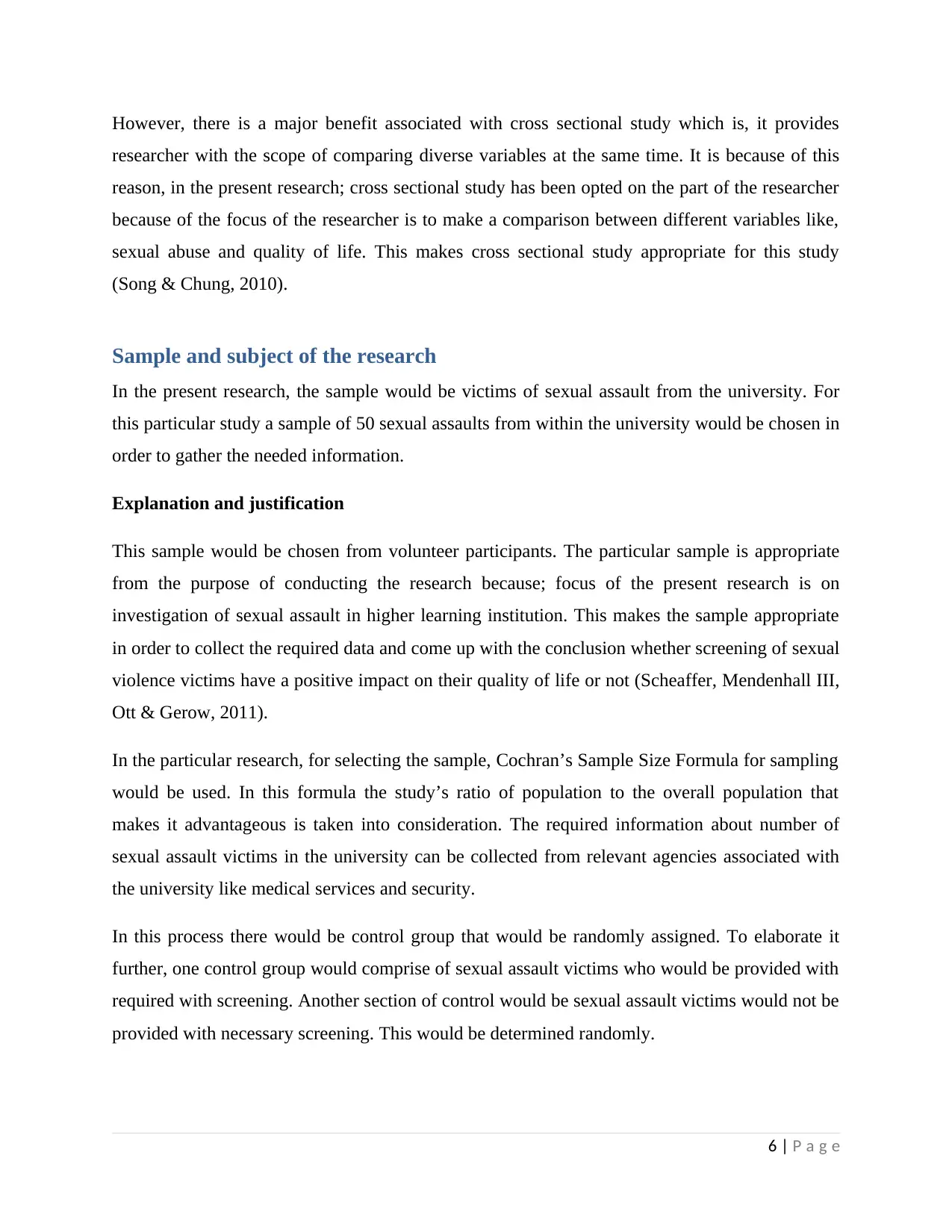
However, there is a major benefit associated with cross sectional study which is, it provides
researcher with the scope of comparing diverse variables at the same time. It is because of this
reason, in the present research; cross sectional study has been opted on the part of the researcher
because of the focus of the researcher is to make a comparison between different variables like,
sexual abuse and quality of life. This makes cross sectional study appropriate for this study
(Song & Chung, 2010).
Sample and subject of the research
In the present research, the sample would be victims of sexual assault from the university. For
this particular study a sample of 50 sexual assaults from within the university would be chosen in
order to gather the needed information.
Explanation and justification
This sample would be chosen from volunteer participants. The particular sample is appropriate
from the purpose of conducting the research because; focus of the present research is on
investigation of sexual assault in higher learning institution. This makes the sample appropriate
in order to collect the required data and come up with the conclusion whether screening of sexual
violence victims have a positive impact on their quality of life or not (Scheaffer, Mendenhall III,
Ott & Gerow, 2011).
In the particular research, for selecting the sample, Cochran’s Sample Size Formula for sampling
would be used. In this formula the study’s ratio of population to the overall population that
makes it advantageous is taken into consideration. The required information about number of
sexual assault victims in the university can be collected from relevant agencies associated with
the university like medical services and security.
In this process there would be control group that would be randomly assigned. To elaborate it
further, one control group would comprise of sexual assault victims who would be provided with
required with screening. Another section of control would be sexual assault victims would not be
provided with necessary screening. This would be determined randomly.
6 | P a g e
researcher with the scope of comparing diverse variables at the same time. It is because of this
reason, in the present research; cross sectional study has been opted on the part of the researcher
because of the focus of the researcher is to make a comparison between different variables like,
sexual abuse and quality of life. This makes cross sectional study appropriate for this study
(Song & Chung, 2010).
Sample and subject of the research
In the present research, the sample would be victims of sexual assault from the university. For
this particular study a sample of 50 sexual assaults from within the university would be chosen in
order to gather the needed information.
Explanation and justification
This sample would be chosen from volunteer participants. The particular sample is appropriate
from the purpose of conducting the research because; focus of the present research is on
investigation of sexual assault in higher learning institution. This makes the sample appropriate
in order to collect the required data and come up with the conclusion whether screening of sexual
violence victims have a positive impact on their quality of life or not (Scheaffer, Mendenhall III,
Ott & Gerow, 2011).
In the particular research, for selecting the sample, Cochran’s Sample Size Formula for sampling
would be used. In this formula the study’s ratio of population to the overall population that
makes it advantageous is taken into consideration. The required information about number of
sexual assault victims in the university can be collected from relevant agencies associated with
the university like medical services and security.
In this process there would be control group that would be randomly assigned. To elaborate it
further, one control group would comprise of sexual assault victims who would be provided with
required with screening. Another section of control would be sexual assault victims would not be
provided with necessary screening. This would be determined randomly.
6 | P a g e
⊘ This is a preview!⊘
Do you want full access?
Subscribe today to unlock all pages.

Trusted by 1+ million students worldwide
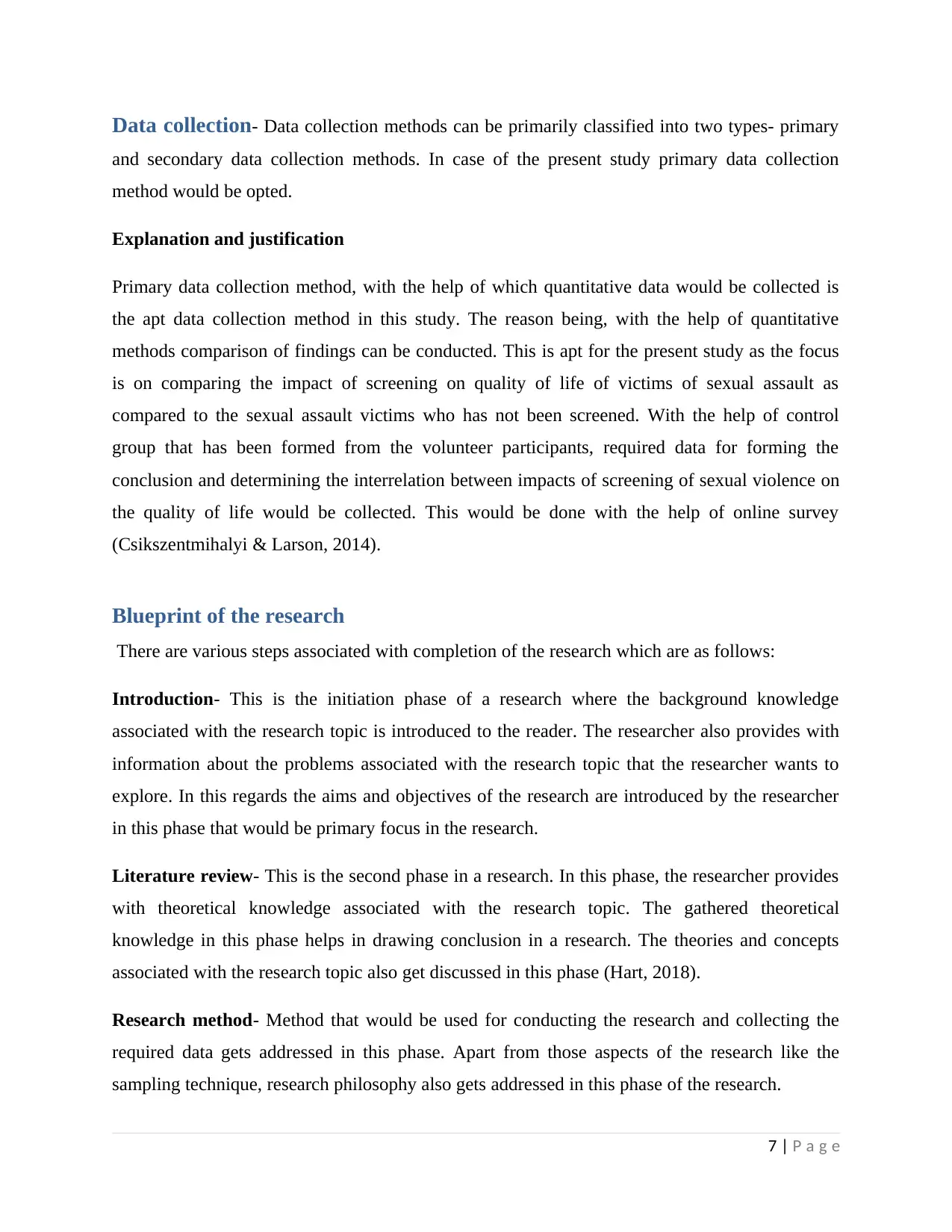
Data collection- Data collection methods can be primarily classified into two types- primary
and secondary data collection methods. In case of the present study primary data collection
method would be opted.
Explanation and justification
Primary data collection method, with the help of which quantitative data would be collected is
the apt data collection method in this study. The reason being, with the help of quantitative
methods comparison of findings can be conducted. This is apt for the present study as the focus
is on comparing the impact of screening on quality of life of victims of sexual assault as
compared to the sexual assault victims who has not been screened. With the help of control
group that has been formed from the volunteer participants, required data for forming the
conclusion and determining the interrelation between impacts of screening of sexual violence on
the quality of life would be collected. This would be done with the help of online survey
(Csikszentmihalyi & Larson, 2014).
Blueprint of the research
There are various steps associated with completion of the research which are as follows:
Introduction- This is the initiation phase of a research where the background knowledge
associated with the research topic is introduced to the reader. The researcher also provides with
information about the problems associated with the research topic that the researcher wants to
explore. In this regards the aims and objectives of the research are introduced by the researcher
in this phase that would be primary focus in the research.
Literature review- This is the second phase in a research. In this phase, the researcher provides
with theoretical knowledge associated with the research topic. The gathered theoretical
knowledge in this phase helps in drawing conclusion in a research. The theories and concepts
associated with the research topic also get discussed in this phase (Hart, 2018).
Research method- Method that would be used for conducting the research and collecting the
required data gets addressed in this phase. Apart from those aspects of the research like the
sampling technique, research philosophy also gets addressed in this phase of the research.
7 | P a g e
and secondary data collection methods. In case of the present study primary data collection
method would be opted.
Explanation and justification
Primary data collection method, with the help of which quantitative data would be collected is
the apt data collection method in this study. The reason being, with the help of quantitative
methods comparison of findings can be conducted. This is apt for the present study as the focus
is on comparing the impact of screening on quality of life of victims of sexual assault as
compared to the sexual assault victims who has not been screened. With the help of control
group that has been formed from the volunteer participants, required data for forming the
conclusion and determining the interrelation between impacts of screening of sexual violence on
the quality of life would be collected. This would be done with the help of online survey
(Csikszentmihalyi & Larson, 2014).
Blueprint of the research
There are various steps associated with completion of the research which are as follows:
Introduction- This is the initiation phase of a research where the background knowledge
associated with the research topic is introduced to the reader. The researcher also provides with
information about the problems associated with the research topic that the researcher wants to
explore. In this regards the aims and objectives of the research are introduced by the researcher
in this phase that would be primary focus in the research.
Literature review- This is the second phase in a research. In this phase, the researcher provides
with theoretical knowledge associated with the research topic. The gathered theoretical
knowledge in this phase helps in drawing conclusion in a research. The theories and concepts
associated with the research topic also get discussed in this phase (Hart, 2018).
Research method- Method that would be used for conducting the research and collecting the
required data gets addressed in this phase. Apart from those aspects of the research like the
sampling technique, research philosophy also gets addressed in this phase of the research.
7 | P a g e
Paraphrase This Document
Need a fresh take? Get an instant paraphrase of this document with our AI Paraphraser
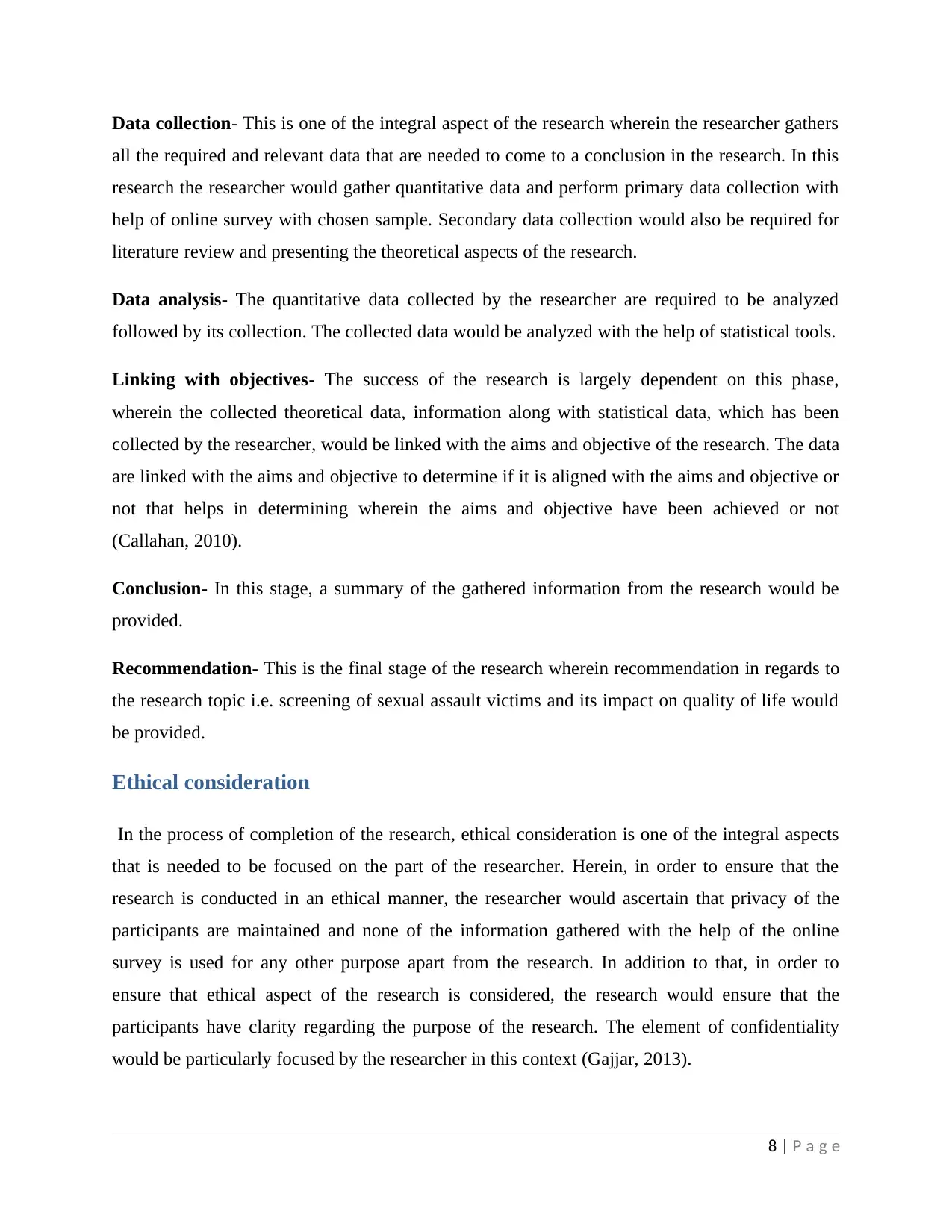
Data collection- This is one of the integral aspect of the research wherein the researcher gathers
all the required and relevant data that are needed to come to a conclusion in the research. In this
research the researcher would gather quantitative data and perform primary data collection with
help of online survey with chosen sample. Secondary data collection would also be required for
literature review and presenting the theoretical aspects of the research.
Data analysis- The quantitative data collected by the researcher are required to be analyzed
followed by its collection. The collected data would be analyzed with the help of statistical tools.
Linking with objectives- The success of the research is largely dependent on this phase,
wherein the collected theoretical data, information along with statistical data, which has been
collected by the researcher, would be linked with the aims and objective of the research. The data
are linked with the aims and objective to determine if it is aligned with the aims and objective or
not that helps in determining wherein the aims and objective have been achieved or not
(Callahan, 2010).
Conclusion- In this stage, a summary of the gathered information from the research would be
provided.
Recommendation- This is the final stage of the research wherein recommendation in regards to
the research topic i.e. screening of sexual assault victims and its impact on quality of life would
be provided.
Ethical consideration
In the process of completion of the research, ethical consideration is one of the integral aspects
that is needed to be focused on the part of the researcher. Herein, in order to ensure that the
research is conducted in an ethical manner, the researcher would ascertain that privacy of the
participants are maintained and none of the information gathered with the help of the online
survey is used for any other purpose apart from the research. In addition to that, in order to
ensure that ethical aspect of the research is considered, the research would ensure that the
participants have clarity regarding the purpose of the research. The element of confidentiality
would be particularly focused by the researcher in this context (Gajjar, 2013).
8 | P a g e
all the required and relevant data that are needed to come to a conclusion in the research. In this
research the researcher would gather quantitative data and perform primary data collection with
help of online survey with chosen sample. Secondary data collection would also be required for
literature review and presenting the theoretical aspects of the research.
Data analysis- The quantitative data collected by the researcher are required to be analyzed
followed by its collection. The collected data would be analyzed with the help of statistical tools.
Linking with objectives- The success of the research is largely dependent on this phase,
wherein the collected theoretical data, information along with statistical data, which has been
collected by the researcher, would be linked with the aims and objective of the research. The data
are linked with the aims and objective to determine if it is aligned with the aims and objective or
not that helps in determining wherein the aims and objective have been achieved or not
(Callahan, 2010).
Conclusion- In this stage, a summary of the gathered information from the research would be
provided.
Recommendation- This is the final stage of the research wherein recommendation in regards to
the research topic i.e. screening of sexual assault victims and its impact on quality of life would
be provided.
Ethical consideration
In the process of completion of the research, ethical consideration is one of the integral aspects
that is needed to be focused on the part of the researcher. Herein, in order to ensure that the
research is conducted in an ethical manner, the researcher would ascertain that privacy of the
participants are maintained and none of the information gathered with the help of the online
survey is used for any other purpose apart from the research. In addition to that, in order to
ensure that ethical aspect of the research is considered, the research would ensure that the
participants have clarity regarding the purpose of the research. The element of confidentiality
would be particularly focused by the researcher in this context (Gajjar, 2013).
8 | P a g e

Figure- Timeline
Conclusion
Based on the above made discussion it can be stated that research design is an integral aspect of a
research that helps it having clarity about the way in which the research is to be conducted. Apart
from providing the research with a direction, it also helps in completing the research in a
systematic manner.
9 | P a g e
Conclusion
Based on the above made discussion it can be stated that research design is an integral aspect of a
research that helps it having clarity about the way in which the research is to be conducted. Apart
from providing the research with a direction, it also helps in completing the research in a
systematic manner.
9 | P a g e
⊘ This is a preview!⊘
Do you want full access?
Subscribe today to unlock all pages.

Trusted by 1+ million students worldwide
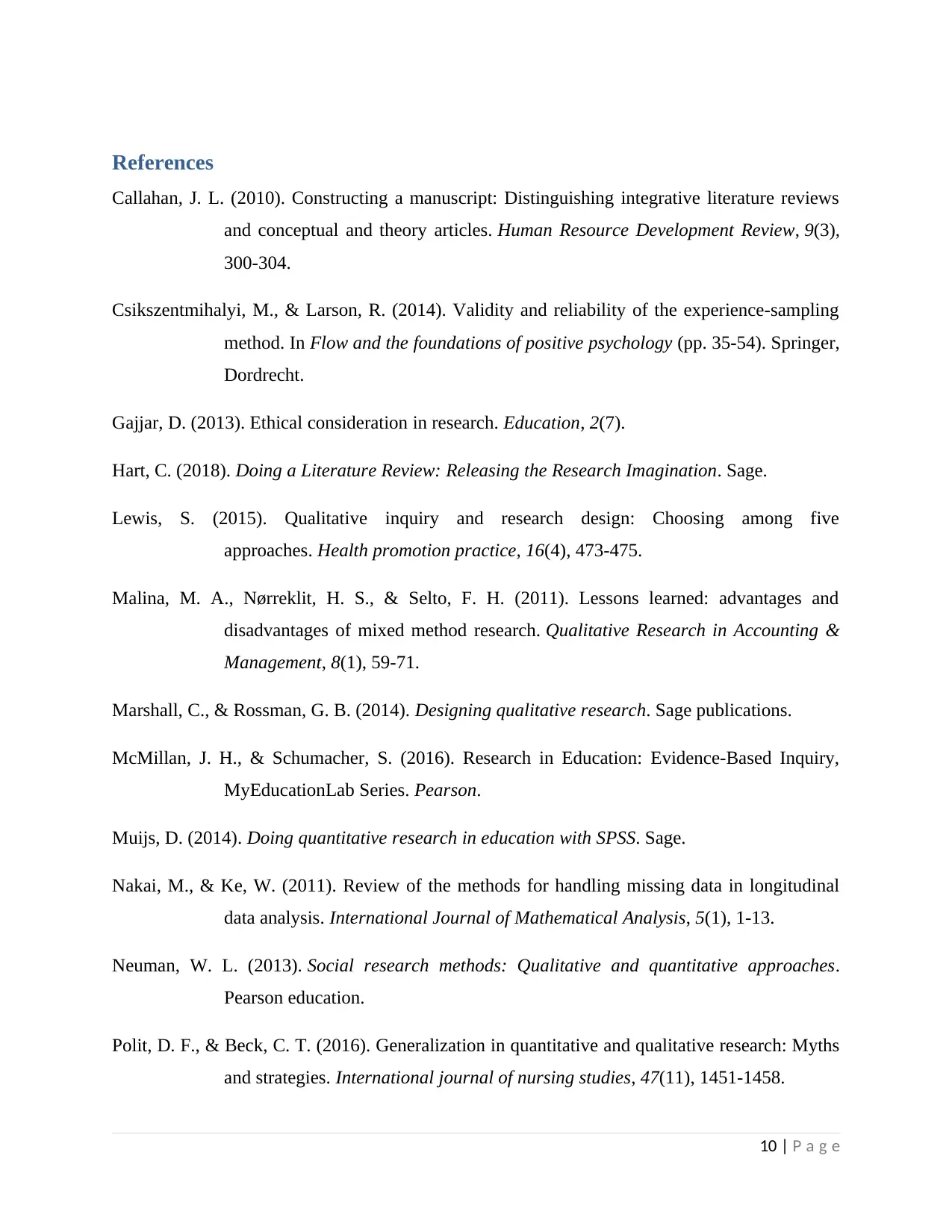
References
Callahan, J. L. (2010). Constructing a manuscript: Distinguishing integrative literature reviews
and conceptual and theory articles. Human Resource Development Review, 9(3),
300-304.
Csikszentmihalyi, M., & Larson, R. (2014). Validity and reliability of the experience-sampling
method. In Flow and the foundations of positive psychology (pp. 35-54). Springer,
Dordrecht.
Gajjar, D. (2013). Ethical consideration in research. Education, 2(7).
Hart, C. (2018). Doing a Literature Review: Releasing the Research Imagination. Sage.
Lewis, S. (2015). Qualitative inquiry and research design: Choosing among five
approaches. Health promotion practice, 16(4), 473-475.
Malina, M. A., Nørreklit, H. S., & Selto, F. H. (2011). Lessons learned: advantages and
disadvantages of mixed method research. Qualitative Research in Accounting &
Management, 8(1), 59-71.
Marshall, C., & Rossman, G. B. (2014). Designing qualitative research. Sage publications.
McMillan, J. H., & Schumacher, S. (2016). Research in Education: Evidence-Based Inquiry,
MyEducationLab Series. Pearson.
Muijs, D. (2014). Doing quantitative research in education with SPSS. Sage.
Nakai, M., & Ke, W. (2011). Review of the methods for handling missing data in longitudinal
data analysis. International Journal of Mathematical Analysis, 5(1), 1-13.
Neuman, W. L. (2013). Social research methods: Qualitative and quantitative approaches.
Pearson education.
Polit, D. F., & Beck, C. T. (2016). Generalization in quantitative and qualitative research: Myths
and strategies. International journal of nursing studies, 47(11), 1451-1458.
10 | P a g e
Callahan, J. L. (2010). Constructing a manuscript: Distinguishing integrative literature reviews
and conceptual and theory articles. Human Resource Development Review, 9(3),
300-304.
Csikszentmihalyi, M., & Larson, R. (2014). Validity and reliability of the experience-sampling
method. In Flow and the foundations of positive psychology (pp. 35-54). Springer,
Dordrecht.
Gajjar, D. (2013). Ethical consideration in research. Education, 2(7).
Hart, C. (2018). Doing a Literature Review: Releasing the Research Imagination. Sage.
Lewis, S. (2015). Qualitative inquiry and research design: Choosing among five
approaches. Health promotion practice, 16(4), 473-475.
Malina, M. A., Nørreklit, H. S., & Selto, F. H. (2011). Lessons learned: advantages and
disadvantages of mixed method research. Qualitative Research in Accounting &
Management, 8(1), 59-71.
Marshall, C., & Rossman, G. B. (2014). Designing qualitative research. Sage publications.
McMillan, J. H., & Schumacher, S. (2016). Research in Education: Evidence-Based Inquiry,
MyEducationLab Series. Pearson.
Muijs, D. (2014). Doing quantitative research in education with SPSS. Sage.
Nakai, M., & Ke, W. (2011). Review of the methods for handling missing data in longitudinal
data analysis. International Journal of Mathematical Analysis, 5(1), 1-13.
Neuman, W. L. (2013). Social research methods: Qualitative and quantitative approaches.
Pearson education.
Polit, D. F., & Beck, C. T. (2016). Generalization in quantitative and qualitative research: Myths
and strategies. International journal of nursing studies, 47(11), 1451-1458.
10 | P a g e
Paraphrase This Document
Need a fresh take? Get an instant paraphrase of this document with our AI Paraphraser
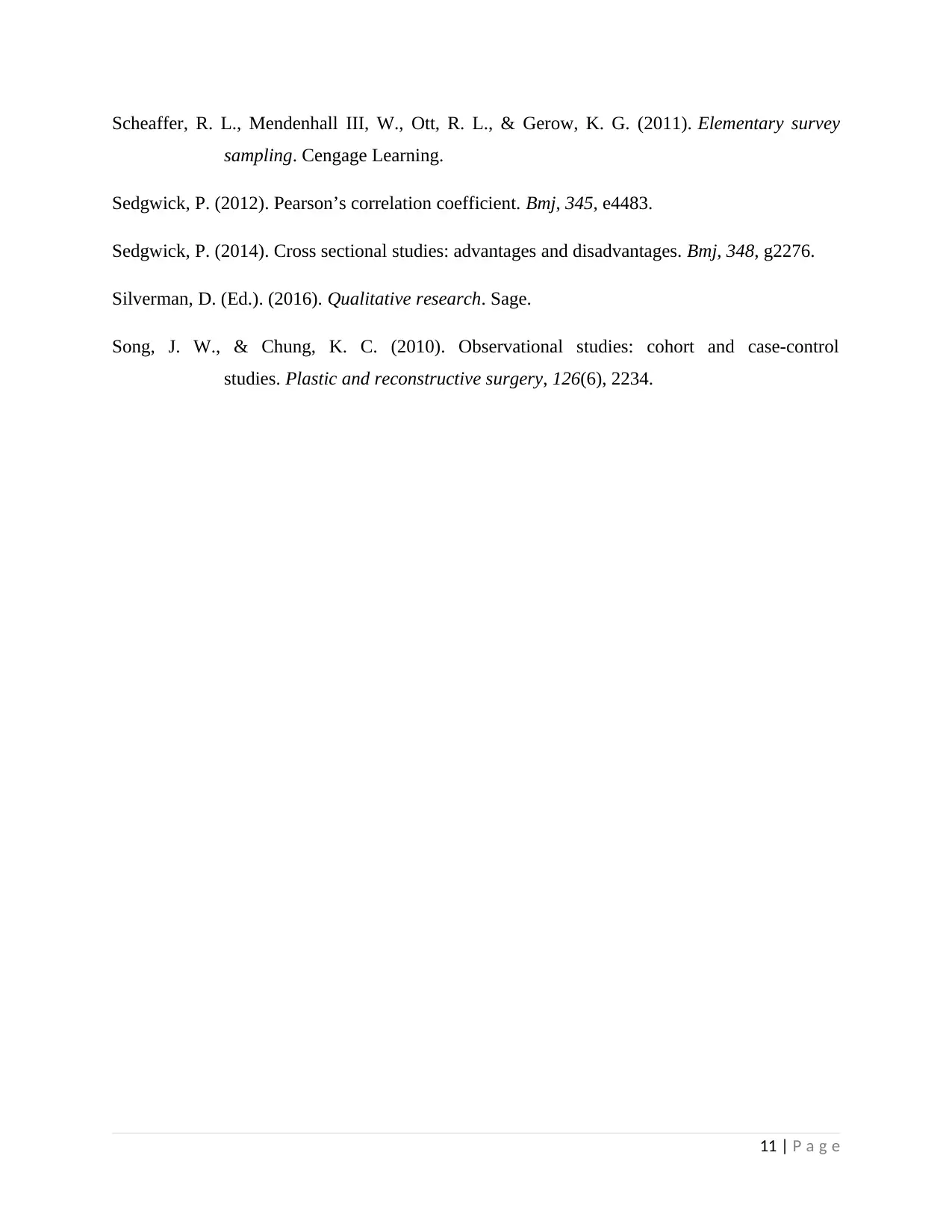
Scheaffer, R. L., Mendenhall III, W., Ott, R. L., & Gerow, K. G. (2011). Elementary survey
sampling. Cengage Learning.
Sedgwick, P. (2012). Pearson’s correlation coefficient. Bmj, 345, e4483.
Sedgwick, P. (2014). Cross sectional studies: advantages and disadvantages. Bmj, 348, g2276.
Silverman, D. (Ed.). (2016). Qualitative research. Sage.
Song, J. W., & Chung, K. C. (2010). Observational studies: cohort and case-control
studies. Plastic and reconstructive surgery, 126(6), 2234.
11 | P a g e
sampling. Cengage Learning.
Sedgwick, P. (2012). Pearson’s correlation coefficient. Bmj, 345, e4483.
Sedgwick, P. (2014). Cross sectional studies: advantages and disadvantages. Bmj, 348, g2276.
Silverman, D. (Ed.). (2016). Qualitative research. Sage.
Song, J. W., & Chung, K. C. (2010). Observational studies: cohort and case-control
studies. Plastic and reconstructive surgery, 126(6), 2234.
11 | P a g e
1 out of 11
Related Documents
Your All-in-One AI-Powered Toolkit for Academic Success.
+13062052269
info@desklib.com
Available 24*7 on WhatsApp / Email
![[object Object]](/_next/static/media/star-bottom.7253800d.svg)
Unlock your academic potential
Copyright © 2020–2025 A2Z Services. All Rights Reserved. Developed and managed by ZUCOL.





